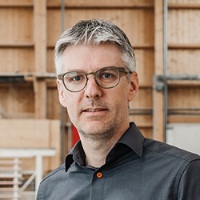Prefabricated timber construction and load-bearing structures

Prefabricated timber construction combines unique architecture with an efficient construction method. Prefabricated load-bearing structures form the suppoerting system of the constructions. Well-conceived planning and production processes and prefabrication in the factory guarantee reliable scheduling and maximum cost transparency. Prefabricated timber construction allows complete design freedom and, moreover, creates pleasant indoor working and living spaces.
Precise prefabricated timber construction
Clients and all others involved in construction projects appreciate the accuracy of planning and production as well as reliable processes with scheduling and cost certainty in prefabricated timber construction.The impressive benefits of prefabricated timber construction stem from the high level of prefabrication of its components.
This shortens the construction phase on site. Noise nuisance or interruptions to rent when properties cannot be leased – such as with a conversion – only last a short time. And by the way: timber’s light weight makes extensions and the addition of storeys possible even in situations where statics requirements leave no scope for other materials.
Advantages of prefabricated timber construction
In prefabricated timber construction, serial prefabrication under controlled conditions produces high-quality components that can be assembled quickly and efficiently on site. The key advantages of this construction method are:
- Production in the factory goes ahead independent of weather conditions, at consistently high quality and exactly according to schedule.
- Building components are planned and produced with complete precision from start to finish.
- The components can be erected quickly at the construction site and do not require any drying time.
- The building components are already set up with provision for electricity, water and heating, or with elements such as balconies or windows.
- Timber as a construction material is inherently lightweight and boasts excellent insulating properties.







